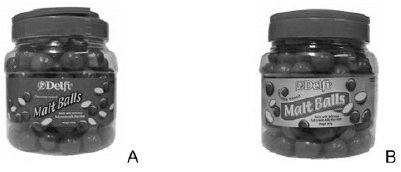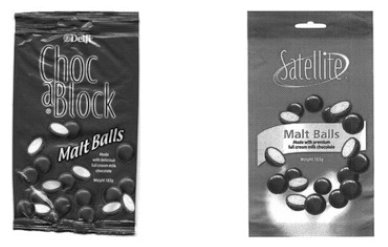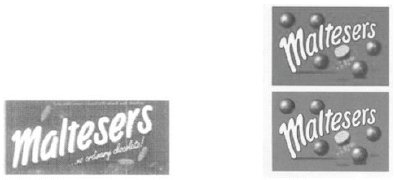First published in the August 2009 edition of the Lexis Nexis Australian Intellectual Property Law Bulletin Maltesers were declared by the primary judge, Perram J, in the recent Federal Court decision Mars Australia Pty Ltd –v– Sweet Rewards Pty Ltd [2009] FCA 606; BC200904981 to be a "victim of their own success".1 His Honour dismissed the applicant's claims for passing off, misleading and deceptive conduct, false representations and trade mark infringement in a recent get-up case against the importers and distributors of the descriptively named "Malt Balls" sold in plastic jars in Target and Kmart in 2005 and 2006 .
In practice
- Ironically, the more well known your clients' get-up is, the more trouble they may have succeeding in a get-up case, owing to the impact that fame will have in assessing the nature of the consumer's imperfect recollection.2 That fame should so influence the court in the application of this doctrine is controversial,3 but perhaps understandable.
- This case also stands for the proposition that (as in the Cheezy Twists –v– Twisties case4 ) where the products are low-cost consumer goods, even though they are likely to be sold on a self-service basis, the aural similarity or dissimilarity of the two product names will nevertheless be significant in the court's assessment of deceptive similarity.
- Composite trade marks comprising the get-up of a product have their place, but will not necessarily deliver success in cases where there is no evidence of intention to copy, and particularly when an alternative brand is used on the allegedly infringing get-up.
Background
A picture tells a thousand words – particularly in a get-up case, so here are pictures of the three products the subject of these proceedings:

The well-known Mars product

The offending products
Jar A was sold in Target and other discount stores and jar B was sold in Kmart, because when asked to approve the original jar A get-up Target replied that it wished its products to be distinguishable from Kmart products.
Importantly, the court found no evidence of intention on the part of the respondent to appropriate Mars's goodwill in its Maltesers product. The fact that these products had been sold previously by the respondent as Choc a Block Malt Balls and Satellite Malt Balls in packet or pouch packaging similar to Maltesers packaging, showing similar illustrations on the packaging of floating chocolate balls, seems to have been significant in the court's conclusions in this regard.
Below are pictures of the Choc a Block and Satellite products:

There is no question that enthusiastic consumers of bite-size chocolate confectionary such as the products pictured above know their Maltesers in the same way other people know their marbles. After all, we've been eating them (Maltesers, not marbles) in Australia for more than 55 years.
Passing off and Trade Practices Act claims
The court held that both jars A and B were sufficiently different from the Maltesers get-up that they did not suggest to "an ordinary consumer of chocolate confectionary the existence of a connexion between the Malt Balls products and Maltesers (or Mars)".5 It was consumers' familiarity with the Maltesers product, and the court's finding as to lack of intention on the part of the respondent, that also allowed the court to dispense with the first passing off claim – that jar A and jar B conveyed a representation that the Malt Balls products were associated with Maltesers products or had the same source or origin.
It was significant that the words "Malt Balls" had been used on the respondent's packaging rather than any word similar to "Maltesers" (such as "Mallesers"), and that "Malt Balls" had not been used in a script and style identical to the Maltesers brand flag.6
The second passing off claim – that jar A and jar B conveyed representations that the Malt Balls they contained were made from the same ingredients, made from the same recipe, or provided the same taste experience as Maltesers when eaten – was also dismissed on the basis of the court's finding that the jar A and jar B were not deceptively similar to the Maltesers get-up. To have found that they were deceptively similar was necessary, the court held, in the absence of any express representations on the packaging to the effect that Malt Balls were like, or tasted like Maltesers.
The third passing off claim – that the depiction of floating brown balls including some depicted in cross-section in itself connotes that the product is a Malteser – was rejected on the basis that there were more important aspects of the Maltesers get-up than the depiction of the product. These elements were the word "Maltesers" and the brand flag/logotype. In addition, the use of the words "Malt Balls" on jar A and jar B "extinguish entirely whatever limited capacity for confusion the floating balls might have otherwise had. To know that one is eating a 'Malt Ball' is to know that one is not eating a Malteser."7
On the basis of the above findings, the claims of misleading and deceptive conduct and false representations under ss 52 and 53 of the Trade Practices Act 1974 were also dismissed.
Claim of trade mark infringement
Mars is the owner of two registered trade marks relevant to these proceedings. They are 789727 and 1122880 and they look like this:

The second mark is a series mark and the court noted that because the second in the series is not in a specified colour it is taken to be registered for all colours.8
In a way this is not a true get-up or "aspects of packaging" case, as the applicant's trade marks in this case incorporated all the aspects of the packaging. Accordingly, there was no question that the applicant was using its get-up as a trade mark, which has often been a problem for the applicant in previous get-up cases. However, the fact that Mars had de-tailed composite registered trade marks comprising the Maltesers get-up did not help it in this case.
The court's primary finding in relation to the claim of trade mark infringement was that the respondent was not using the whole of the label on its jars as a trade mark – the only part of the label that it was using as a trade mark was the "Delfi" mark, which was obviously not deceptively similar to the Maltesers marks. This finding disposed of the trade mark claims.
Perram J went on, however, to consider whether, if (contrary to the above finding) each element of the label that was alleged to breach Mars's trade marks was actually used as a trade mark by the respondent, that use was deceptively similar to the Mars trade marks.
Judging the marks in their entirety and on impression based on recollection as required by the authorities,9 rather than a sideby- side comparison, it seems that Maltesers fame went against them again. "The Maltesers marks are very famous", therefore:
...a comparison between the impression held in the consumer's mind and the direct impression of the Sweet Rewards's mark is one which, in this case at least, occurs in a context in which the chances of the average consumer having forgotten the Maltesers mark are vanishingly small.10
In other words:
Consumers are so familiar with Maltesers that they could not possibly be confused by the Malt Balls packaging – more formally, there is no likelihood of imperfect recollection by them of the Maltesers mark leading to confusion.11
His Honour also said that "I regard the aural similarity between Malt Balls and Maltesers as negligible",12 which he said assisted him in the above conclusion.
Comment
As noted in the In Practice box, the type of products in this case and the trade mark infringement claim in this matter call to mind the Cheezy Twists –v– Twisties case of 2001.13 The respondent, Aldi, prevailed in its appeal to the Full Court of the Federal Court after being found at first instance to have infringed the Twisties trade mark, owing to findings of intent to appropriate, and of aural similarity between "Cheezy Twists" and "Twisties".
The Full Court (2 to 1) held that there was no deceptive similarity. Interestingly, in that case the owner of the Twisties trade mark had not even attempted to bring passing off and trade practices claims as well, presumably because it was fairly obvious that the typical Aldi customer would not have been misled.
The Maltesers case is further evidence that the courts are now giving Australian consumers the credit for being able to tell their Maltesers from their Malt Balls.
Mars filed an appeal against this decision on 26 June 2009.
Footnotes
1 At [32].
2 Contrast Coca-Cola Company –v– All-Fect Distributors Ltd 45 IPR 481 (Full FC), where the fame of the shape of the appellant's bottle in fact assisted in a claim against similarly shaped confectionary, but note that this was a "shape" case rather than a "get-up" case.
3 Shanahan et al, Shanahan's Australian Law of Trade Marks and Passing Off 3rd ed, 2003 Thomson Reuters at [18.105].
4 Aldi Stores Ltd partnership –v– Frito-Lay Trading Company GmbH (2001) 190 ALR 185; 54 IPR 344; [2001] FCA 1874; BC200108283 at [156] and Australian Woollen Mills Ltd –v– FS Walton & Co Ltd (1937) 58 CLR 641 at 658 ; 11 ALJR 186.
5 At [30].
6 At [32].
7 At [80].
8 At [84] and Trade Marks Act 1995 (Cth) s 70(3).
9 For example, Australian Woollen Mills Ltd –v– FS Walton & Co Ltd (1937) 58 CLR 641; 11 ALJR 186 and Crazy Ron's Communications Pty Ltd –v– Mobileworld Communications Pty Ltd (2004) 209 ALR 1; 61 IPR 212; [2004] FCAFC 196; BC200404917.
10 At [97].
11 At [98].
12 At [95].
13 Above n 4.
The content of this article is intended to provide a general guide to the subject matter. Specialist advice should be sought about your specific circumstances.


